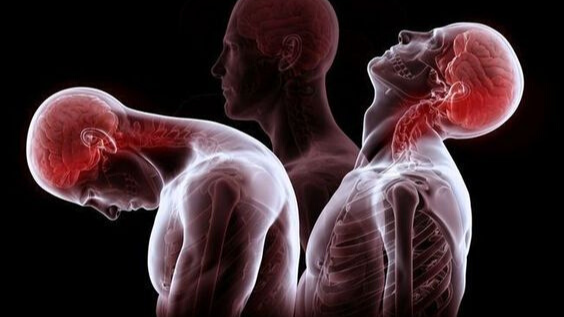
Whiplash sufferers: the nemesis of many a manual therapist. Let’s start by defining whiplash. Although there have been many descriptions over the years, this definition by Barnsley et al in 1994 has stood the test of time:
‘An injury to one or more of the cervical spine that arises from inertial forces being applied to the head in the course of a MVA that results in the perception of the neck pain.’
There have been numerous phases, titles and acronyms used to describe the neck pain arising from a motor vehicle accident (MVA), ranging from: ADI = Acceleration/Deceleration injury to CNP = Chronic Neck Pain, and more. The most widely acceptable term clinically (and in the literature) that encompasses debilitating neck pain arising from trauma in WAD = Whiplash Associated Disorder.

It is important to remember that whiplash is not a diagnosis but a mechanism of injury. The most common cause of WAD presenting to clinics around the world is from motor vehicle accidents, particularly, a rear end collision. It is this mechanism of injury that will be the focus of this article. However, we cannot overlook an increasing cause of WAD in today’s modern society which is that of overuse (and abuse) of technology. But let’s save that discussion for another time.
According to the Australian Institute of Health and Welfare website, here are some statistics related to car accidents in 2016:
> there were 145 accidents per 100,000 of population in Australia
> with approximately 33,000 MVAs in Australia, which equates to
> 8000 serious injuries in the state of Victoria alone
These injuries come with debilitating costs in both economic and non-economic terms and certainly present a clinical challenge for manual therapists.

Mechanism of injury
Here is an actual time frame of events leading to neck trauma in a rear collision. You will note that the average rear end collision occurs in about 250 milliseconds or one quarter second. The injury causing portion of the collision occurs in the first 75 milliseconds, or in the blink of an eye.
At 50 milliseconds post-impact, the car seat back pushes the torso forward, the spine moves forward, resulting in the straightening of the thoracic and cervical spine.
At 75 milliseconds pot-impact of the collision, the car seat is rapidly pushing the occupant’s torso forward, while the head remains stationary due to inertia. This difference in motion between the neck and torso results in an S-shaped curve, where nearly all of the bending in the cervical spine takes place in the lower cervical spine. This rapid bending in just a few joints can result in ligament damage in the lower spine. The rapid motion of the neck during a crash can result in a number of injuries – many of which are impossible to see on x-rays or MRI.
Defining WAD
In 1995, the Quebec Task Force (QTF) developed a classification system that was designed to improve the management of WAD by providing a guide to the sign and symptoms of whiplash indicative of the seriousness of the injury sustained (see below). This system helps guide the assessment and diagnosis of WAD. It is important that clinicians can identify signs and symptoms indicative of the various levels of severity of WAD so that appropriate management can be undertaken. Systems and disorders that can manifest in all grades include, but are not limited to, dizziness, tinnitus, headache, memory loss, dysphagia and temporomandibular joint pain.

Below is a copy of that classification system.
0 – No complaint about neck. No physical sign(s).
I – Neck complaint of pain, stiffness or tenderness only. No physical sign(s).
II – Neck complaint AND musculoskeletal sign(s). Musculoskeletal signs include decreased range of motion and point tenderness.
III – Neck complaint AND neurological sign(s). Neurological signs include decreased or absent deep tendon reflexes, weakness and sensory deficits.
IV – Neck complaint AND fracture or dislocation.
To further assist clinicians in the management of acute WAD, stiell et al in 2001 described and published the Canadian C-Spine rule for radiography in alert and stable trauma patients. This rule has the potential to significantly reduce the clinical practice variation and ED inefficiency in Cx spine radiography. Further details on how to apply this early assessment tool can be found in the article by Stiell.

Acute Management of WAD
When a patient presents with WAD it is important to take an extensive history as well as gather baseline data via self-administered questionnaires (which should be repeated periodically to determine the clinical efficiency of treatment interventions and patient management plans). At a minimum, you should collect the following details:
> Thorough history relating to the accident, including speed at which the car was hit, and an idea of weight differential between the vehicles (for example, if a 1000kg vehicle hi a 500kg vehicle at 50km/hr, then the article force is doubled)
> When did the patient first feel symptoms after the accident? If immediately, this typically indicates a more significant pathology. Typically, it is over the next few days as swelling, stiffness and muscle guarding take effect.
> Past history is also very relevant: has your patient had previous neck issues, history of headaches, previous MVAs and if so, what impact did they have at that time?
> It is also recommended that practitioners complete at least 2-3 questionnaires such as:
1: Neck Disability Index (Vernon & Mior 1991)
2: Symptom Intensity Rating (Davidson & De Nardis 2011) and the
3: Impact of Events Scale (IES)(Weiss, 2007)
Note: these questionnaires should be repeated periodically to determine the clinical efficiency of treatment intervention and patient management plans.

MVA guidelines
The following guidelines stem from several reference sources as well as over 20 years’ clinical experience in assessing and treating clients suffering with acute and chronic WAD ate the Melbourne Whiplash Centre. There is adequate research to suggest that active interventions are preferable to passive interventions (Verhagen et al Cochrane review 2000, NSW Govt endorsed review 2014)
Guidelines include:
> Acute us considered in the first 12 weeks post MVA
> Easrly active interventions, such as simple cervical rotations actively performed on the hour is important to maintain the neck range of mobilise neural structures (Rosenfeld 2003)
> Consider take home information, written details to educate the patients
> Reassure client that the majority of MVA victims recover within a 12-week time frame
> Encourage normal activity but not strenuous activity in first 7-10 days
> Consider imaging via Canadian C-spine rule
> Referral to GP for pain reliving medication, blocking the pain encouraging movement is important
> Sensible use of neck collars – certainly not establishing a reliance on one, but wearing a collar for short periods of the day or when traveling can offer relied from pain sensitive structures and assist recovery
> Close monitoring is important, consider questionnaires, phone calls
> Manual hands-on treatment should not commence until the patient can confidently tell you that for at least 48 hours their symptoms have stabilized. This may be more then several days post-impact. Regular monitoring of the patient during this time is recommended and should symptoms deteriorate then referral to a specialist or GP is required.

Acute Whiplash Guidelines
To consider…
>Patient education/take home written information
> Sensible use of collars
> Encourage normal activity
> Imaging
> Medication for pain relief
> Sick leave
> Website (www.whiplashcentre.com)
> Specialist referral
Early WAS Management at the Melbourne Whiplash Centre (Grades I-III)
Scenario:
> Patients present for an appointment or by phone 24-48 hours
> Ma y or may not already have plain radiographs
Stage 1: Inflammatory Stage
> Educate
> Respect pathology
> Offload structures
Consider
> re-assurance, diagrams, providing information and advice
> Manage as acute spinal disc
> Decrease weight bearing , sensible use of collars, extended periods in supine
> Analgesics as required
> Instruct to take two days away from work
Home program
> Hourly routine of active range of motion exercises
> 6-10 Cervical rotations
> 6-10 Shoulder shrugs/circles
> 6-10 Arm/shoulder basic ROM
> Walk 3 X 15-20 minute periods

Advice
> Rest in supine, not on couch: cervical rotations can be performed in supine
> Encourage to do light home duties
> Refrain from sport or moderate intensity.. No contact sport
> sensible use of collars – as you may use crutches for a sprained ankle
> Instruct on use of heat/cold
Note
> Avoid aggressive retraction in assessment or treatment with WAD
> Immediate movement may reduce the fear of serious injury
> Rotations may be important to mobilise the contralateral neural structures
> Gentle cervical/shoulder movements may decrease the inhibition of neurovascular blood flow
> During this phase, patient should call daily, sometimes twice per day to monitor symptoms
This phase may last 1-4 days. It is strongly recommended that you refrain from manual intervention until 24 hours after symptoms have stabilized.
This information is provided by courtesy of the Melbourne Whiplash Centre
